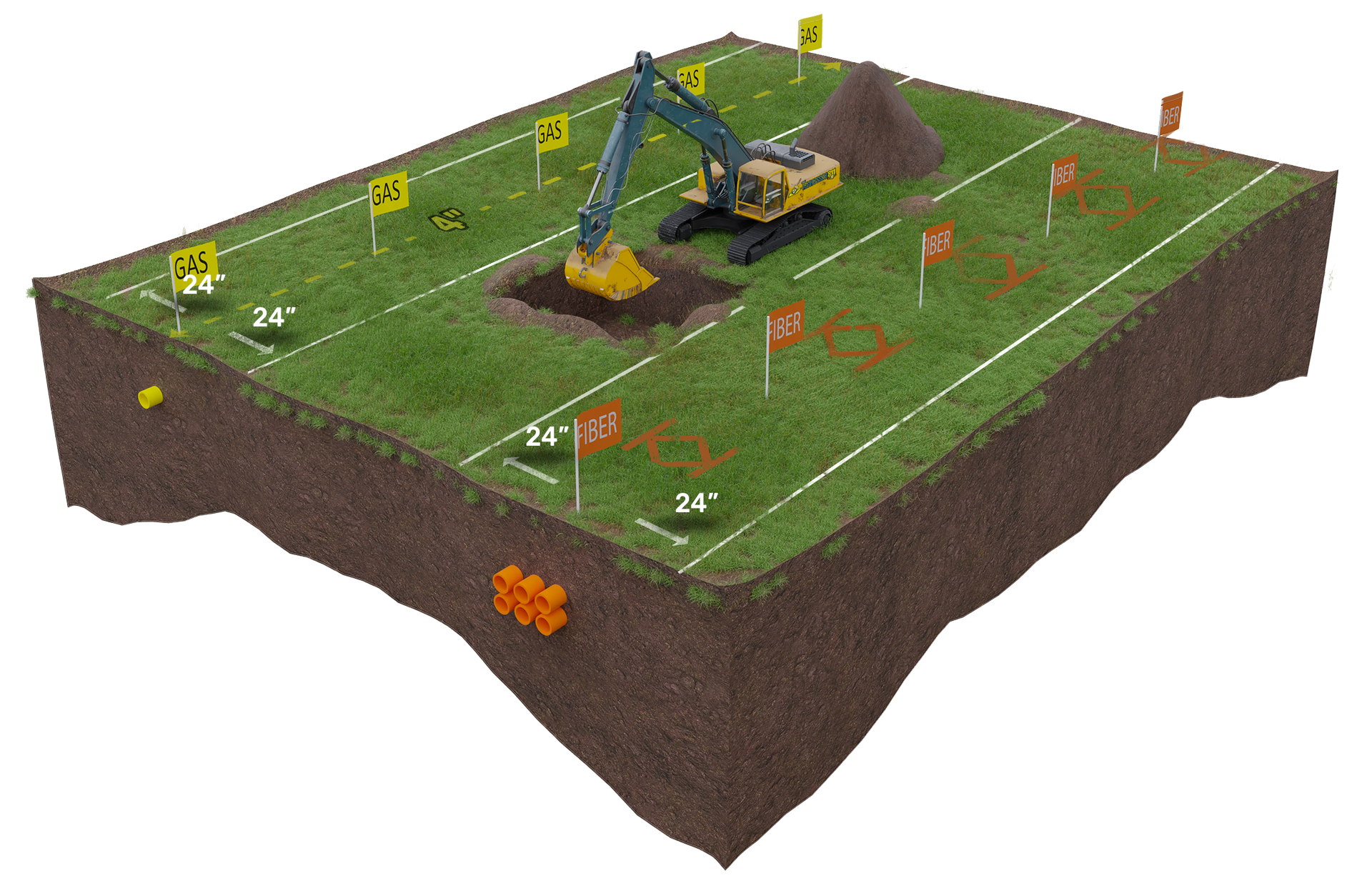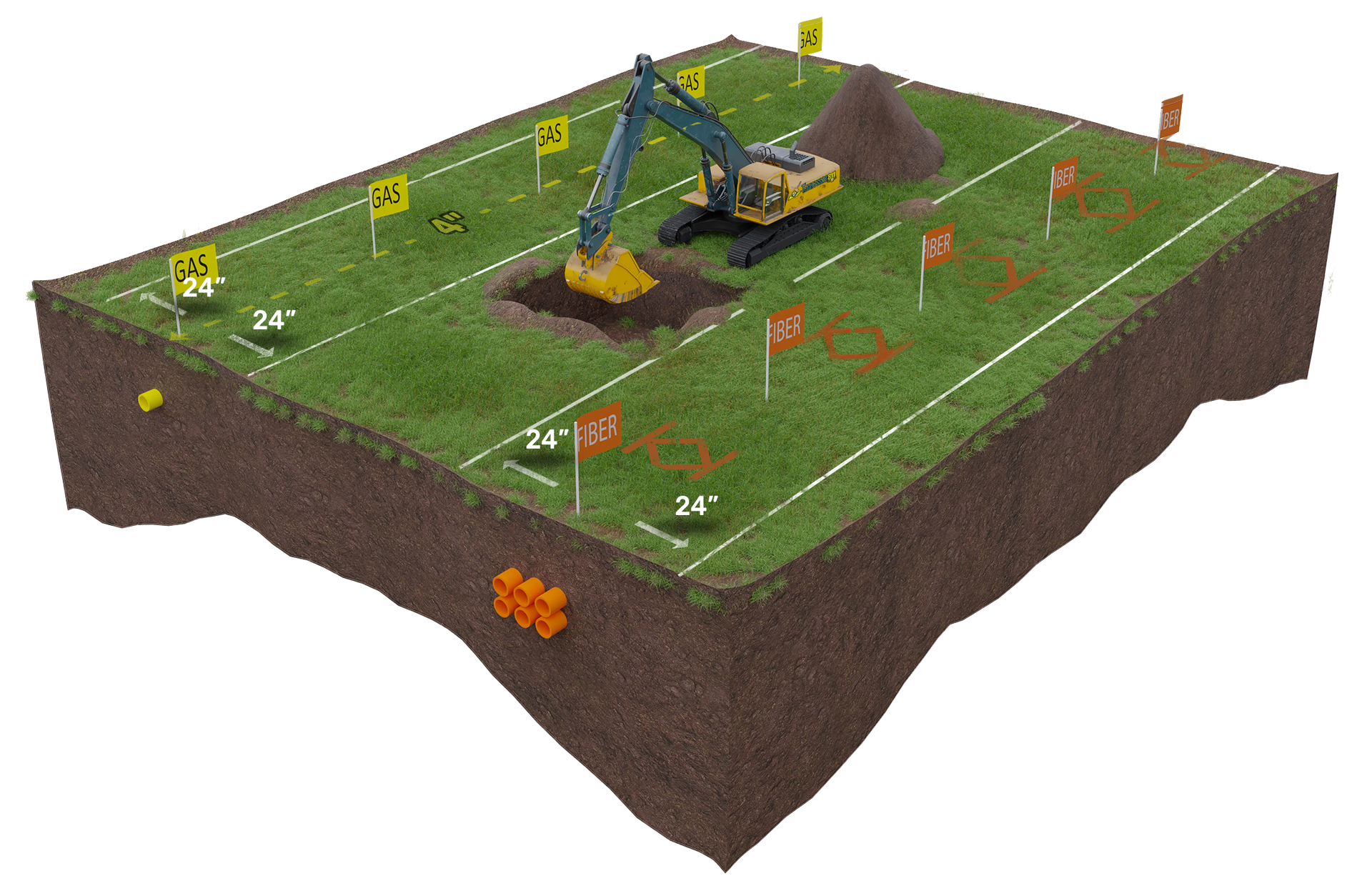Before You Dig
Steps to Safe Digging
Safe digging is everyone’s responsibility, but excavators have more responsibilities under the law and higher risk if the proper processes aren’t followed. Submitting a ticket is the first step but it’s not the only step, and sometimes it takes more than just the one call.
1. Plan your project.
Gather all the information you need for your locate ticket. White lining your proposed dig site with white paint or flags if/when possible.
You’ll need the following information handy when you contact us:
- Your name, company name (if applicable), phone number, and mailing address.
- Field contact information.
- Type of work to be done.
- The county, city, address, and nearest cross street of the proposed excavation site.
- Where on the property you want marking done.
The proposed areas of excavation can be marked with white paint in order to show the location or boundaries of the proposed excavation. This helps with the efficiency of the locate process.
Facility operators may not locate or mark private underground facilities. To learn more about private vs public utilities, go here.
2. Submit a ticket.
Submit your ticket by calling 811 or (800) 351-1111 or by one of our online entry options.
A normal locate request requires at least three (3) working days' notice. That’s 72 hours excluding weekends and holidays.
You can provide as much as ten (10) working days' notice when you know that your schedule is a little more flexible – we call this “postdating” a ticket. Because of the high volume of tickets each day, postdating your ticket and giving more than three days’ notice may mean that you can better rely on the start date of your ticket.
3. Wait for marks.
You will need to wait to start your work until the legal start date and time on your ticket. This allows all affected facility owners the required time to mark their facilities. The more notice you give the more likely the facilities will all be able to respond prior to your excavation start date.
4. Check ticket responses.
You can view up-to-date responses from all utility companies notified by Tennessee 811 by checking Positive Response.
Positive Response is a service that TN811 provides to help you track the status of your locate request.
5. Confirm the marks.
Once you’ve received responses from all members, compare the ticket response codes to the marks you see at the dig site. If they don’t match, contact 811 to have a 2nd Notice sent to that member.
6. Dig with care.

Locating is not an exact science; therefore, the actual location of the facility could vary from the position of the marks.
Tennessee state law establishes a tolerance (or safety zone) that is the width of the buried facility plus 2 feet (or 24 inches) on each side. The tolerance zone is often based on the surface marking provided by utility locators, but utility locating is not an exact science, so the best way to pinpoint of a buried line is to carefully expose it.
Utilities are not required to provide depth information with their utility markings, and the depth of a utility line can vary over time, even if an as-built drawing reflects depth of cover at the time of installation.
7. If needed, extend the life of your ticket.
Tickets are valid for fifteen (15) calendar days after the legal start date requested on the Tennessee 811 ticket.
If your excavation will not be completed within fifteen (15) calendar days, contact 811 three (3) working days prior to the expiration of your ticket to request an update to ensure that your ticket does not expire during excavation. Working on an expired ticket is against state law and may result in you being reported to the state and being responsible for repair costs if a damage occurs.
Once you have completed digging, do not continue to update the ticket.
Uniform Color Code
The uniform color code is used for marking excavation sites and underground facilities in conflict with an excavation.
Underground facilities may be marked on the ground in either paint, stakes, or flags.
Tolerance or Safety Zone
Tennessee state law requires excavators to exercise reasonable care when working inside the tolerance or safety zone. The tolerance zone is the width of the buried facility plus two (2) feet (or 24 inches) on each side.

Public and Private Utilities
Facility operators may not locate or mark private underground facilities.
Not all underground facilities buried in your yard are maintained by utility operators, which means some lines may not be marked after you contact Tennessee 811.
Here are some examples of underground facilities that, as the property owner, you are responsible for having located:
- Water or sewer lines from the main line to your home.
- Propane lines from your tank to your home or between your home and other structures on your property, such as a garage.
- Electric and gas lines are typically marked only up to the meter but may extend to other buildings, yard lights, or additional areas on your property.
- Irrigation lines.
If you have private underground facilities on your property, it is your responsibility to have them located. Underground facility operators did not install these lines and, therefore, cannot locate them for you.
To help ensure these private lines are properly identified, we provide a list of
private utility locating services operating in Tennessee. While we do not endorse or recommend specific companies, you are welcome to contact any service that meets your needs.
Public Utilities
Public utilities are owned and maintained by municipalities or utility companies and are part of a large public network. Examples of public utilities are water mains, buried electric lines, gas mains, fiber optic and telecommunications lines, and sewers.
When approaching a home, the public utility will usually end at the meter, or the point of service. (Points of service can also be a transformer, vault, valve, or junction box.)
Private Utilities
Private utilities extend beyond the public utility network and are typically the responsibility of the property owner.
Examples would include:
- Power to detached garages, barns, pool heaters, and landscape lighting.
- Lines to septic systems and water lines running from the water meter to your home.
- Sewer lines connecting the city or county system to your home.
- Irrigation systems.
- Invisible pet fences.
- Propane lines, as well as connections for grills.
- Well Lines.

